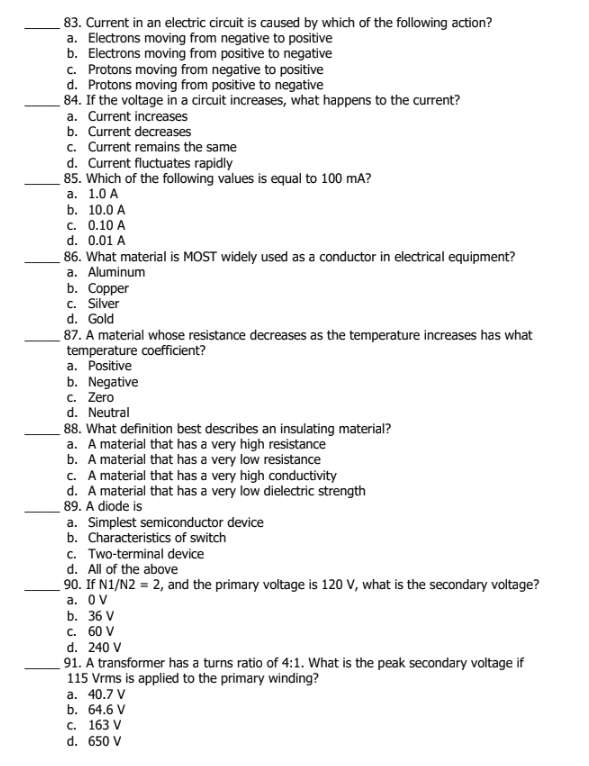83. Current in an electric circuit is caused by which of the following action? a. Electrons moving from negative to positive b. Electrons moving from positive to negative c. Protons moving from negative to positive d. Protons moving from positive to negative 84. If the voltage in a circuit increases, what happens to the current? a. Current increases b. Current decreases c. Current remains the same d. Current fluctuates rapidly
83. Current in an electric circuit is caused by which of the following action? a. Electrons moving from negative to positive b. Electrons moving from positive to negative c. Protons moving from negative to positive d. Protons moving from positive to negative 84. If the voltage in a circuit increases, what happens to the current? a. Current increases b. Current decreases c. Current remains the same d. Current fluctuates rapidly
Introductory Circuit Analysis (13th Edition)
13th Edition
ISBN:9780133923605
Author:Robert L. Boylestad
Publisher:Robert L. Boylestad
Chapter1: Introduction
Section: Chapter Questions
Problem 1P: Visit your local library (at school or home) and describe the extent to which it provides literature...
Related questions
Question
Answer all the items. Thanks!

Transcribed Image Text:83. Current in an electric circuit is caused by which of the following action?
a. Electrons moving from negative to positive
b. Electrons moving from positive to negative
c. Protons moving from negative to positive
d. Protons moving from positive to negative
84. If the voltage in a circuit increases, what happens to the current?
a. Current increases
b. Current decreases
c. Current remains the same
d. Current fluctuates rapidly
85. Which of the following values is equal to 100 mA?
а. 1.0 A
b. 10.0 A
с. 0.10 A
d. 0.01 A
86. What material is MOST widely used as a conductor in electrical equipment?
a. Aluminum
b. Сорper
c. Silver
d. Gold
87. A material whose resistance decreases as the temperature increases has what
temperature coefficient?
a. Positive
b. Negative
C. Zero
d. Neutral
88. What definition best describes an insulating material?
a. A material that has a very high resistance
b. A material that has a very low resistance
c. A material that has a very high conductivity
d. A material that has a very low dielectric strength
89. A diode is
a. Simplest semiconductor device
b. Characteristics of switch
c. Two-terminal device
d. All of the above
90. If N1/N2 = 2, and the primary voltage is 120 V, what is the secondary voltage?
а. OV
b. 36 V
с. 60 V
d. 240 V
91. A transformer has a turns ratio of 4:1. What is the peak secondary voltage if
115 Vrms is applied to the primary winding?
a. 40.7 V
b. 64.6 V
C. 163 V
d. 650 V
Expert Solution
This question has been solved!
Explore an expertly crafted, step-by-step solution for a thorough understanding of key concepts.
Step by step
Solved in 2 steps with 2 images

Knowledge Booster
Learn more about
Need a deep-dive on the concept behind this application? Look no further. Learn more about this topic, electrical-engineering and related others by exploring similar questions and additional content below.Recommended textbooks for you

Introductory Circuit Analysis (13th Edition)
Electrical Engineering
ISBN:
9780133923605
Author:
Robert L. Boylestad
Publisher:
PEARSON

Delmar's Standard Textbook Of Electricity
Electrical Engineering
ISBN:
9781337900348
Author:
Stephen L. Herman
Publisher:
Cengage Learning

Programmable Logic Controllers
Electrical Engineering
ISBN:
9780073373843
Author:
Frank D. Petruzella
Publisher:
McGraw-Hill Education

Introductory Circuit Analysis (13th Edition)
Electrical Engineering
ISBN:
9780133923605
Author:
Robert L. Boylestad
Publisher:
PEARSON

Delmar's Standard Textbook Of Electricity
Electrical Engineering
ISBN:
9781337900348
Author:
Stephen L. Herman
Publisher:
Cengage Learning

Programmable Logic Controllers
Electrical Engineering
ISBN:
9780073373843
Author:
Frank D. Petruzella
Publisher:
McGraw-Hill Education

Fundamentals of Electric Circuits
Electrical Engineering
ISBN:
9780078028229
Author:
Charles K Alexander, Matthew Sadiku
Publisher:
McGraw-Hill Education

Electric Circuits. (11th Edition)
Electrical Engineering
ISBN:
9780134746968
Author:
James W. Nilsson, Susan Riedel
Publisher:
PEARSON

Engineering Electromagnetics
Electrical Engineering
ISBN:
9780078028151
Author:
Hayt, William H. (william Hart), Jr, BUCK, John A.
Publisher:
Mcgraw-hill Education,